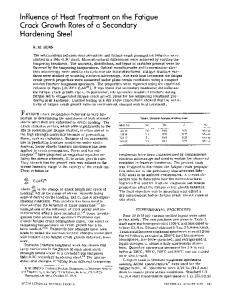A Novel Heat Treatment Process for Surface Hardening of Steel: Metal Melt Surface Hardening
- PDF / 2,414,632 Bytes
- 5 Pages / 593.972 x 792 pts Page_size
- 17 Downloads / 416 Views
hardening is one of the most effective strategies to increase the fatigue life of workpieces made from cast iron, medium-carbon steel, and tool steel by improving their wear and corrosion resistance, which has been widely investigated during the past several decades.[1,2] One of the most widely applied mechanisms for surface hardening of steel is to form a surface layer composed of martensite through heat treatment, i.e., rapid heating and subsequent quenching. So far, several heat treatment technologies for surface hardening have been developed, such as flame surface hardening (FSH), induction surface hardening (ISH), laser surface hardening (LSH), electron beam surface hardening (EBSH).[3–10] Constrained by the respective heat sources exploited in these technologies, each of these technologies has its own advantages and disadvantages. Taking the state-of-the-art LSH technology for example, the as-processed surface of steel can obtain a hardened surface layer with a very low thermal distortion of the
YONG-SHENG FU, WEI ZHANG, XIAOWEI XU, JUN LI, MINGXU XIA, and JIANGUO LI, are with the School of Materials Science and Engineering, Shanghai Jiao Tong University, Shanghai 200240, P.R. China. Contact e-mail: [email protected] JIEHUA LI is with Casting Research, Montanuniversitt Leoben, 8700 Leoben, Austira. Manuscript submitted January 6, 2017.
METALLURGICAL AND MATERIALS TRANSACTIONS A
component, compared with the traditional surface hardening technologies such as FSH and ISH. However, LSH also suffers several drawbacks, e.g., high equipment costs, inadequate utilization of laser energy, back tempering, etc.[7] Developing a better heat source is, therefore, of great importance for surface hardening. It is well accepted that the interfacial heat transfer behavior happening during the solidification of metal melt on metal substrate is similar to the case of LSH, which indicates its potential application in surface hardening of steel. Bouchard et al. found that the peak heat flux could reach 10 MW/m2 in their research about the interfacial heat transfer during the solidification of aluminum melt on copper substrate. Furthermore, the peak heat flux could increase to 45 MW/m2 after the addition of magnesium as the surface active element.[11] The research of Strezov et al. about the solidification of AISI 304 stainless steel melt on copper substrate also revealed the peak heat flux could exceed 10 MW/m2. Furthermore, a coating with a layer of MnO-SiO2 eutectic on the copper substrate exhibits a better wettability than AISI 304 stainless steel melt on copper substrate and can increase the maximum heat flux to 50 MW/m2[12,13] In our previous research about the solidification of AISI 304 stainless steel melt on copper substrate, a peak heat flux with the value of 15 MW/m2 was achieved, and the peak heat flux could be increased to 20 MW/m2 with a Zn coating.[14] It is worth noting that, due to the delay in heating of thermocouples, the peak heat flux is in fact underestimated. During the surface hardening process of steel by heat treatmen
Data Loading...











